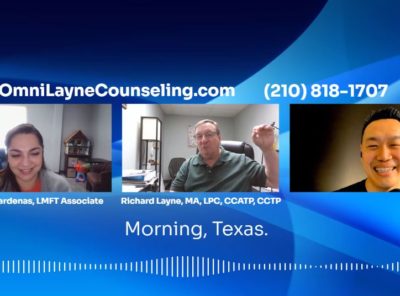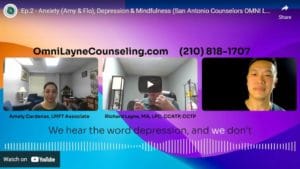Show Notes
[00:00:00] Sherman Hu: Welcome to another podcast powered by OMNI Layne Counseling. I have Richard and Amely joining me here today. How are you folks doing?
[00:00:09] Amely Cardenas: Doing well.
[00:00:10] Richard Layne: We’re doing great. Hello, Texas. We’re here for you.
Would you define what trauma is?
[00:00:13] Sherman Hu: That was brilliant. Let’s unpack a very important topic and that’s trauma. Would you define for me what trauma is?
[00:00:23] Richard Layne: That’s a very interesting question, Sherman.
[00:00:26] I looked at five dictionary definitions of trauma. All five of them had some differences and some similarities.
[00:00:34] Today we have two types of trauma according to the dictionary.
[00:00:38] We have physical trauma and we have psychological trauma.
[00:00:42] And some of the differences were like one dictionary said “severe psychological trauma or severe psychological insult fed to the trauma”.
[00:00:52] That’s not necessarily true.
[00:00:54] Being insulted can actually lead to trauma or being traumatized.
[00:00:59] This has [00:01:00] created a problem with our clients that are coming in, through social media, and with YouTube in particular. People are hearing all these different things.
[00:01:09] They’re now confused about what the term trauma is.
[00:01:12] Putting it in a very simple way is this. Trauma is any insult or injury. Bottom line. That’s what trauma is.
[00:01:25] We start moving beyond that, we were getting into complexities, which we’ll cover in a moment in this podcast.
[00:01:33] With the definition being very confusing, remember we talked about labeling last time, labeling can play into it here, and be very confusing for people also.
Trauma Victims vs Trauma Survivors
[00:01:46] Richard Layne: When you hear about trauma, you hear about “trauma victims”.
[00:01:51] I don’t like the term “trauma victims”. They’re “trauma survivors”.
[00:01:57] Being a trauma survivor, then she could move [00:02:00] on. You can do different things. You can actually get well once again. Because PTSD, which is what most people associate now with trauma is actually very treatable, very treatable.
[00:02:15] A lot of the people here is not, in essence, unfortunate. But I like to have them experience both personally, and as a counselor has shown me was very treatable disorder.
[00:02:27] What do you think, Amely?
“A Bad Thing Happened” – Children’s Book Describing Trauma to Kids
[00:02:29] Amely Cardenas: I definitely agree. There’s a good children’s book that describes trauma to kids, and it’s called “A Bad Thing Happened”.
[00:02:37] Trauma is a bad thing that happened. The definition of trauma, I think of it as a spectrum. It’s not necessarily abuse or something assaultive.
[00:02:45] Grief. People that have lost people. I think of men and women in the armed forces that have lost colleagues. I think of people that have lost many family members. People that have been in natural disasters.
Secondary Trauma
[00:02:58] Amely Cardenas: It’s not necessarily [00:03:00] like it happened directly to you. And that’s another thing with trauma, there’s also Secondary Trauma.
[00:03:05] And the biggest example I always give is 9-11. The people that were physically in New York, 100% that was primary trauma directly happening in front of them. But the rest of the country was watching the twin towers collapsing, they were watching these planes coming down from the sky.
[00:03:25] And that was scary. I was in the first grade, but my parents talking about it, they were terrified. They were like, “What is going to happen?”. And as a military brat, my dad’s in the service. And so that was also another conversation.
Trauma affects the person, and everyone else within the family
[00:03:41] Amely Cardenas: I think with trauma, it doesn’t only affect the person. It affects everyone else within the family.
[00:03:47] And I definitely agree, Richard, the term “survivor” is 100%, “You’re going to get through this. You’re going to see the other side.”
[00:03:56] They use the term survivor for cancer [00:04:00] patients. They use “cancer survivor” because you beat the odds. You did everything to get to the other side.
[00:04:07] And that’s the thing. With any type of disorder, any type of thing that brings you to therapy, as long as you’re wanting it, you can get to the other side. It’s very hard, but you can definitely get to the other side of it.
[00:04:21] Richard Layne: I want to go back to this term, “survivor” for just a second and “secondary trauma”.
[00:04:26] I wanted everybody to know I’m a trauma survivor. Very serious trauma, actually. And I got through it. Through counseling, really helped a lot. Two years. And a lot more work after that. I’ve been working on myself for over 30 years at this point in my life. My life has gotten much better, so you can definitely move forward as a survivor.
[00:04:47] If you look at yourself as a victim, you could be trapped as a victim.
[00:04:51] Now for “secondary trauma”, I want to give everybody a life example of my own.
[00:04:56] 9-11. I will never forget that day 9-11 happened. [00:05:00] I was at home and I wasn’t even watching television and my girlfriend and wife now, Diane, called me.
[00:05:08] She said, “Hey, have you seen the news, what’s going on?”
[00:05:12] I said, “No, let me turn a TV on.”
[00:05:14] And 9-11 was unfolding right before my eyes. And I will never forget the news media replaying and replaying the airplane going into the building. And I was sitting here going, “Oh, I just can’t take this anymore.”
[00:05:29] I was getting retraumatized watching that and I eventually turned it off.
[00:05:35] Secondary Trauma is very real. Secondary Trauma can happen to everyone around you, not just your wife, et cetera.
[00:05:43] Amely Cardenas: The professionals in our career, in our field, in the medical field, journalists, everyone that’s witnessing second-hand what happened. Even reading about it, watching it. We’re human. It’s going to affect [00:06:00] us.
Various Complexities of Trauma: Complex Trauma
[00:06:00] Sherman Hu: And this is actually blowing my mind and really expanding my perspective or realm of what trauma is. When Richard mentioned that it’s any incident or injury, that’s very all encompassing.
[00:06:16] And so there must be different levels, or complexity of trauma. I know you talked about primary and secondary trauma, but there must be different complexities or levels. I’m wondering if you guys can expand on that?
[00:06:32] Amely Cardenas: There’s also Complex Trauma.
[00:06:33] I used to work with kids in the foster care system. And for a lot of them, I don’t like to use this phrase, but they were getting retraumatized – all the terms that you hear within the foster care system and the CPS world.
[00:06:46] These kids would go to either new foster homes or to adoptive homes or, back to home.
[00:06:53] And instead of it being a safe place, it ended up not being and they got [00:07:00] retraumatized. They either experienced the same type of trauma they had experienced, the reason why they got removed, or something brand new.
[00:07:07] And I also think of our soldiers out there, going for another tour. Not every tour is the same. Not everything they’re going to witness is the same.
[00:07:17] Even in our profession, even though we’ve heard it all, there is going to be still one thing that we have not heard, and at the end of the day, I always tell my clients, “It’s not going to surprise me and I’m not going to judge you. The only thing, I’m human, so I’m going to be concerned. I have to have some type of reaction.”
[00:07:33] But it can’t be all about me. The only way I feel like I really can show that empathy is by showing concern like, “Oh my goodness, that should never have happened to you.”
[00:07:43] So complex trauma is one trauma after the other.
[00:07:46] And it doesn’t have to be simultaneously. It could be spaced out over time. Survivors can do the work, go to therapy, but then something happens and it brings them back to those behaviors and those [00:08:00] triggers or flashbacks even, that feel like they’re starting all over, but it is a different trauma that’s repacking their exisitng trauma.
[00:08:12] Richard Layne: Talking about levels of trauma: this happens occasionally also. Let’s say you and I, Sherman, are standing side by side. And let’s say a plane crashes right in front of us. For some people you might have one person over going “Ahhhh”, and the other person goes “No big deal!”.
[00:08:35] Trauma affects everyone differently, especially at first. And one of the most common things is you can go through a quote unquote dramatic experience and not experience any symptoms of PTSD for six months to a year. And sometimes later. It just hit you.
[00:08:54] Sherman Hu: Wow.
[00:08:56] Is it because of how amazingly we’re [00:09:00] wired? Our brains protecting us from that moment until that incident is way past. And then it relaxes and then you see the impact of it?
Social Upbringing, Cultural Norms & Trauma
[00:09:09] Richard Layne: It has a whole lot to do with our biology and our cultural upbringing and our social upbringing, et cetera. But it also has to do with the way the amygdala functions in the brain. And we’re not going into that right now, but the amygdala is very important for these types of reactions. And everybody’s functions differently.
[00:09:34] Amely Cardenas: Amy’s (Amygdala) job is to pull the fire alarm. Traumatic happens, she’s in charge.
[00:09:39] I like what you said, Richard. There’s all these different things that make us. Which is controlled by society, our biology. At the end of the day, based on those things, that’s how we’re going to respond.
[00:09:50] Culturally, you were taught to not talk about your feelings ever. You’re going to bottle it up. Of course you’re not in a box in terms of your [00:10:00] culture. You can respond whether or not you share your emotions.
[00:10:04] What was it you said? If a plane crashed, someone’s going to respond and others are going to be in shock and others are just going to flee. The fight, flight or freeze.
Trauma & Young Children
[00:10:13] Sherman Hu: You brought up something that triggered a thought on Amely. I always believed that our modeling is our default mode and so I can’t help, but think of the children growing up in families where they are highly discouraged from showing emotion, like you just mentioned bottling, ” men don’t cry”, that kind of stuff. And if Richard says that trauma is every incident or injury and what I thought what about modeling, there must be with children, young children, it must impact them totally different, then it does older children or adults. How is that [00:11:00] with young children?
[00:11:03] Amely Cardenas: It’s hard because they’re taught one thing at home, but then at school, they’re also taught another thing. I think the school districts, some of them are really pushing for mental health awareness and they have counselors there or they’ll even recommend “this kid can’t come back until they seek professional help.”
[00:11:22] It’s very hard.
[00:11:23] “Do I show my emotions? Do I not?”
[00:11:26] It’s this internal battle of what do I do?
[00:11:29] “My parents were saying one thing, but then my teachers and my classmates, and maybe the rest of the society is expecting another.”
[00:11:38] And so I think it’s always going to be a cultural clash.
Emotions are not bad
[00:11:41] Amely Cardenas: Education about “emotions are not bad”. Anger, jealousy. They’re natural, like how we were talking about anxiety and depression a couple of episodes ago.
[00:11:50] They are so natural. We would not have survived without them. I think of the cave men days. If they didn’t have anger, they wouldn’t have cared if [00:12:00] their friend, got ill and died. Those emotions matter. It’s finding a way to show them in a way that is acceptable on both ends.
[00:12:09] If we’re angry, we either use our words or we take a break. It doesn’t have to necessarily mean bottle up, but it could be, how do we show it without showing it?
[00:12:19] It’s meeting in the middle with a compromise. “Okay, this kid needs to show something. And how are you supposed to know what they need unless they tell you?”
[00:12:28] Can we use at least our words to show emotion instead of physically on our face?
[00:12:33] Or, can you at least take a step out?
[00:12:36] I tell kids, “Can you take a step out of the classroom?”
[00:12:38] Or, “Take a step into your room, do what you need to do to calm down and then rejoin once you’re ready.”
[00:12:46] It can be a lot of learning how to create their own safety and their own coping skills in terms of “How do I show my emotions and not get in trouble at the same [00:13:00] time?”
[00:13:00] I think it’s always going to be an ongoing battle.
[00:13:02] For a long time, certain family members didn’t really believe in my profession. And depression wasn’t a thing. And so that’s also hard to hear as a kid.
[00:13:13] As long as we’re continuing to say, “Hey, your feelings are valid and natural. I’m sorry that not everyone is going to agree with that, but how do we show them in a way that’s good for you and good for them?”
[00:13:27] And that’s the true nature of a compromise is something that you’re happy with and they’re happy with.
[00:13:31] So sometimes you’re not going to get all of it, but I think for these kids, can we get at least 50% of it?
Has the definition of trauma changed over the years?
[00:13:40] Sherman Hu: Richard, you were mentioning earlier about how you define trauma. Has the definition of trauma changed over the years?
[00:13:46] Richard Layne: It has. I’m very much into etymology, which is study of words and word origin.
[00:13:51] All my adult life I have loved it. So I’ve looked up deaf, different types of definitions over the years. The psychological [00:14:00] definition – I’m seeking the dictionaries now – are very new. They didn’t used to be there at all. The trauma meant an insult or an injury of some kind.
[00:14:11] And another major influence: There are tons of trauma videos out there now. There’s somebody called Complex PTSD now, which is not even in our book. Someone has named it.
[00:14:25] We have Trauma.
[00:14:26] We have Narcissistic Trauma.
[00:14:28] We have Borderline Trauma. Trauma, trauma.
[00:14:31] There are thousands of them, at least. And people watch these, they will watch a bunch of them.
[00:14:39] And some of the people who were doing these videos are professionals. And some aren’t. So they get differing information. They get lots of different definitions of what’s going on out there.
[00:14:53] And then we’ll hear a person’s perspective, and they think that’s the only perspective. But then if you listen to the next [00:15:00] person, of course, you’re going to ignite a totally different perspective.
[00:15:03] Yes, there is a lot of confusion going on about it right now. And unfortunately the American Psychological Association is not really helping, because the definition of trauma that is in our DSM-5-TR now, I think it needs some work. I really do.
[00:15:21] They say there’s a difference between children six years and younger.
[00:15:25] The definition for PTSD and six or over six years.
[00:15:31] But when you look at it, you don’t really see it. So we need lots and lots of work.
[00:15:36] But please remember the definitions of trauma and PTSD are very new, right? Okay.
[00:15:42] Remember for the DSM-5 came out, that the definitions of trauma and PTSD were it was a soldiers’ problem. Vietnam veterans, that’s their problem.
[00:15:53] Not for that poor little kid that was beat up in the corner. Now how they was tied up and put into the closet for a [00:16:00] week.
[00:16:00] So things are changing quite a bit, but we definitely need some work on this.
Different Treatment Modalities for Children and Adults Experiencing Trauma
[00:16:06] Sherman Hu: Talking about working on it. There must be different modalities or types of treatment in working with children and adults. Am I right about that?
Play Therapy for Trauma
[00:16:18] Amely Cardenas: For kids specifically, a lot of professionals will do “Play Therapy”.
[00:16:23] I think Play Therapy is a great way for the kid to express themselves. There are also, within the Play Therapy realm, “Sand Trays”. You can learn a lot about a kid by they’re playing with the sand.
[00:16:34] Are they compacting it? They’re smashing it. Or are they just letting it run freely?
[00:16:40] Even with toys.
[00:16:41] A lot of investigators will use toys to figure out, “Hey, what happened? Can you show me on this doll what happened to you?
[00:16:49] Or, ” Can you draw me a picture?”
[00:16:50] I know with art, for a lot of kids, they’ll draw me pictures of what’s going on.
[00:16:54] ” Can you show me what happened?”
[00:16:55] Or, “Can you tell me how your day was?”
[00:16:57] Even with families. ” Who is in your family?” And draw [00:17:00] the family members and ask questions and being curious.
[00:17:03] “Okay, what does this mean?” “What does that mean?”
[00:17:05] With Play Therapy, you can go in every direction.
[00:17:08] Sometimes I do a little bit of Narrative. I ask them to create a story based on what we’re playing with. Or, just based on either real life or on fairy tale. Sometimes their reality is seeping into their play or their pretend time.
[00:17:26] Definitely play therapy for kids.
Cognitive Behavioral Therapy (CBT) for Trauma
[00:17:28] Sherman Hu: Richard, the adults? Any modalities that are commonly worked with?
[00:17:34] Richard Layne: Oh, yes. In general, most therapists use Cognitive Behavioral Therapy for treating trauma.
[00:17:41] However, unfortunately, Cognitive Behavioral Therapy has some limitations.
[00:17:47] And one of the limitations is it does not tend to focus on the emotions and feelings very much at all.
[00:17:54] It also tends to be very time limited. A lot of therapists will say, “Oh, 18 [00:18:00] sessions. We’re done. You’re cured.”
[00:18:01] That’s not true, of course. So CBT is a big way, it can be helpful.
CBT and Neuroscience Counseling
[00:18:06] Richard Layne: But I find the CBT works best with Neuroscience Counseling.
[00:18:13] The study of the brain and cognitive reframing. And for people to understand, and anxiety in particular, comes from two different primary sources, which we’re really not gonna get into right now.
[00:18:25] But those take two varied approaches.
[00:18:29] Not only that, with cognitive reframing, one of the things I explain to people very often is , ” You’re going to do the cognitive reframing, but the very first time though, it may not work.”
[00:18:40] It can take time. And I tell everybody, “Some things, very short amount of time. You’re going to be done. You’re walking in the street. I’m done. Okay.
[00:18:49] And then other times, it’s going to be like, “Oh, is it ever going to be through?”
[00:18:56] This a very important point to remember. Very [00:19:00] important because people can do things differently.
[00:19:05] Their traumas can be different. They can react differently. Your brain can also react differently to different traumas. So one thing for you could be very profound, and deep, and take that extreme amount of time to get over. And some of them definitely another thing “Hmm, no big deal.” And you’re pretty much over it.
Exposure Therapy
[00:19:28] Richard Layne: There’s also potentially Exposure Therapy. Exposure Therapy is used mostly with the military, quite frankly, these days. However you can use it in counseling also. It takes a lot of setup and alot of practice and a lot to procedure with trauma survivors. It can be very effective for some and not so effective for others.
Dialectical Behavior Therapy (DBT)
[00:19:54] Richard Layne: Also, you can use that Dialectical Behavior Therapy with trauma survivors.
[00:19:59] Because [00:20:00] partially what I like with Dialectical Behavior Therapy is putting structure and using mindfulness to help them in part with structure. They help the person relax and go, “Okay. It’s not that bad. I’m really not dying. I promise.”
[00:20:15] Mindfulness is very effective for all counseling clients, quite frankly.
[00:20:20] Some people, just talk therapy. Just coming in and talking about things. We can do all of this other stuff.
[00:20:26] They’re looking at me and go, “Oh, I just want to talk about things.”
[00:20:30] I have that happen occasionally as well.
[00:20:32] Amely Cardenas: Sometimes just talking about it, getting someone to give some feedback or just to listen. Sometimes it’s “I need to word vomit on you. I just need to let it out.” And other times it’s, “I need you to actually say something back to me.”
[00:20:47] Sometimes, I’ll even tell kids and parents. When they’re telling you something, asking at the beginning, “Hey, before we sit down and talk, do you want me to listen to you? Or do you want me to give feedback, [00:21:00] so that I’m listening.”
[00:21:01] Because it’s the difference between passive listening and active listening.
[00:21:05] ” Hey, I hear you like, wow. That’s very difficult. What are you going to do about it?”
[00:21:10] And asking questions as we go. But others are just like, “I just need to tell you about my day and then I’ll be good.”
[00:21:17] Sherman Hu: Husbands too. Communicating with their wives.
[00:21:22] Amely Cardenas: Oh my gosh. There’s a great video to explain that in “Modern Family.”
[00:21:26] There was a fight between Phil Dunphy and his wife, and he was trying to solve her problem. All she wanted was for him to listen. He was at a spa and the women were like, “What are you doing? She just wanted you to listen to her. You didn’t want to solve her problems.”
[00:21:45] When we were talking about trauma, how for some people it works and for others, doesn’t really work for me. And same thing for the responses. Sometimes a car accident really affects someone’s [00:22:00] ability to drive again. And others, ” I just get back in my car and drive.”
[00:22:04] Sherman Hu: It definitely does sound nuanced. It does sound complex and very layered. And that can be a lot of improvements. As you said, Richard, with DSM and navigating the different layers of it. As we wrap up today’s episode, Richard, do you have any final words to viewers with regards to trauma?
Having trauma does not mean you have a mental health disorder
[00:22:24] Richard Layne: Yes. Just because you have a trauma does not mean you have a mental health disorder.
[00:22:33] It doesn’t necessarily mean you have a huge stress disorder. Doesn’t mean PTSD. Or even Adjustment Disorder. You’ve been exposed to a trauma. That’s what it really means at that point.
Thorough trauma assessment conducted at OMNI Layne Counseling
[00:22:43] Richard Layne: We do a very thorough assessment here for trauma. We look for anxiety in relation to the trauma. Depression in relationship to the trauma. Disassociations in relationship to the trauma. Flashbacks.
[00:22:59] All of [00:23:00] that is a part of our diagnosis that we do for the clients when they come in. Okay. And if you don’t fall into those categories, then guess what? You probably don’t have PTSD. Okay.
[00:23:16] I hear people coming in all the time. This is a little bit off subject, but it’s a great example.
[00:23:22] “I’m OCD.”
[00:23:25] “What do you mean you’re OCD?”
[00:23:26] “I just like to have things my way.”
[00:23:29] ” Okay. Is that all?”
[00:23:31] “Well, yeah.”
[00:23:32] “Then you’re probably not OCD. Or you probably don’t even have OCD.”
[00:23:36] It’s just, you’re a Type A personality. That’s a different issue.
[00:23:40] But we hear this all the time out there and that’s part of this confusion we can go back to just being created by books, is being created by YouTube, social media, your brother, your sister, whatever, it’s all out there.
[00:23:57] So here’s the main thing. If you think [00:24:00] you have a mental health problem, go to a counselor. Go to a psychologist. Come here, please. Make the appointment at OmniLayneCounseling.com.
[00:24:11] And we will do our best to diagnose you properly when you’re here. But please remember when you come in, be honest with your counselor. Tell your counselor everything that is going on. If we don’t hear it, sometimes we don’t see it. It depends.
[00:24:32] Sherman Hu: Because you can’t read minds.
[00:24:33] Richard Layne: Correct.
[00:24:34] Sherman Hu: Any final words to viewers about trauma?
[00:24:38] Amely Cardenas: Yeah I definitely 100% agree with Richard. Going back to labels, you are not your trauma. Your trauma is just a little piece of you that happened to you.
[00:24:50] And it does not mean you’re crazy or that, now you have to have a new label of a mental disorder. We’re human. We’re not [00:25:00] supposed to be perfectly fine after a trauma. That’s too much to ask of you. And so definitely reach out. Even if it’s not to a professional, at least to a family member or friend, so that, sometimes you feel like you need to be alone, but that is the best time to not be alone.
[00:25:18] Even if it’s not that severe. Maybe it’s best to get a second opinion so that a friend or family can be, ” I don’t think you’re okay. I think you need to talk to someone.”
[00:25:29] I think it’s best to still continue to talk to friends and family, but come see us. Come see a counselor in another practice. I would hope that you’d come see us, but I think at the end of the day, people are here for you. We are definitely here for you. So take advantage of it. Be honest. Be vulnerable. I know it’s really hard. Sometimes it’s better to get it off your chest than to keep it bottled up.
[00:25:52] Sherman Hu: That’s great. Thank you, Richard and Amely. We covered a lot of ground today about trauma. We unpacked the definition. Different [00:26:00] complexities of it. Modalities. Influence. And I love the compassion of what you shared with our viewers at the end here with your final words.
[00:26:08] So for those viewing, those listening, amazing topic on trauma today.
[00:26:13] Thank you for joining us. Stay tuned next week with OMNI Layne Counseling.




